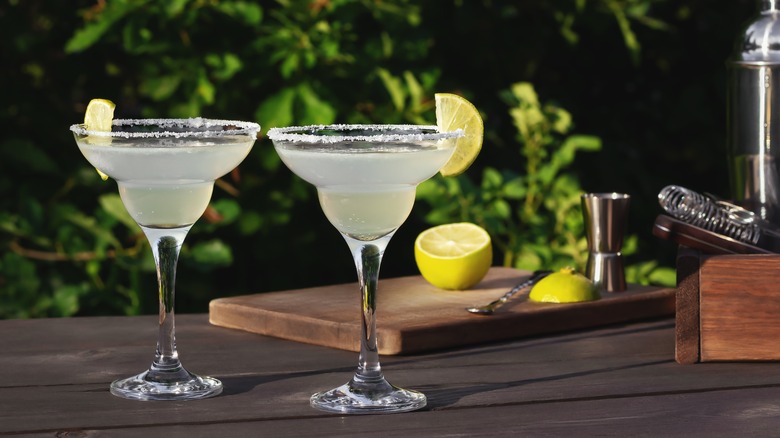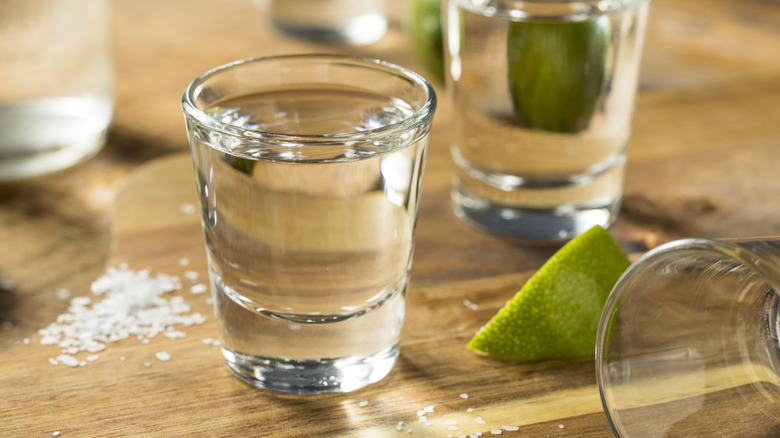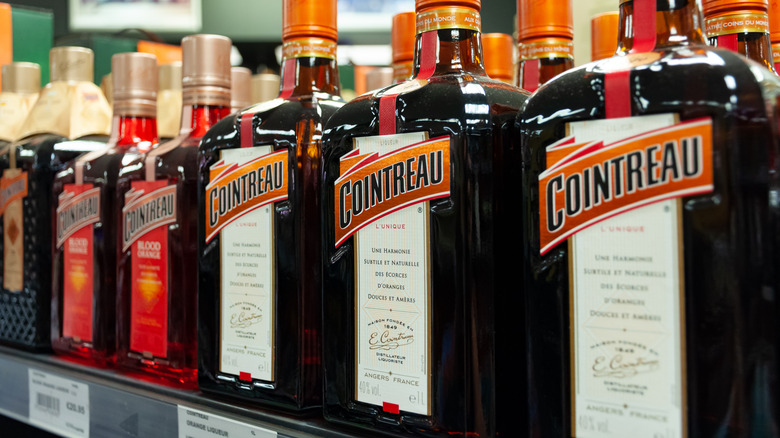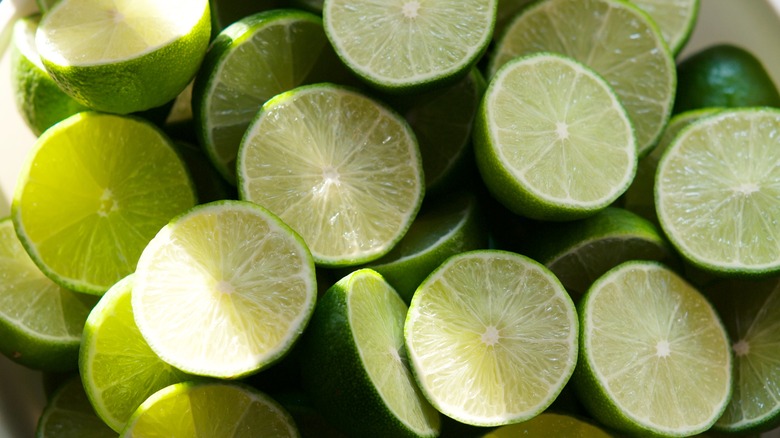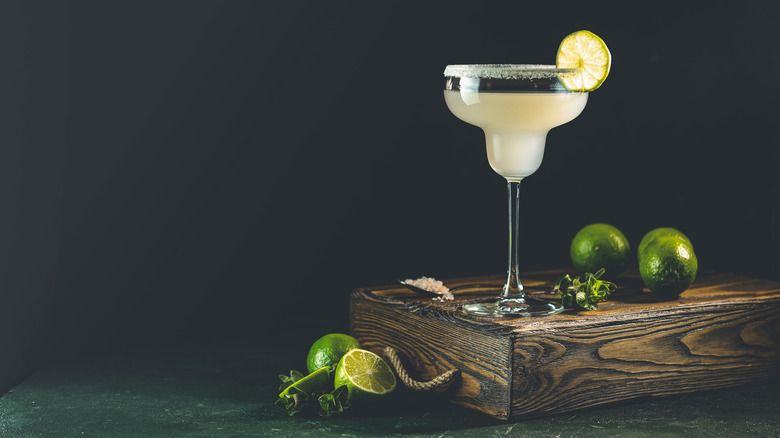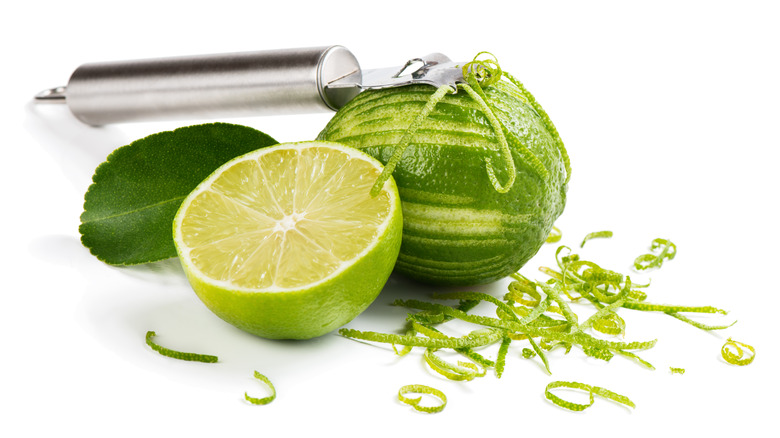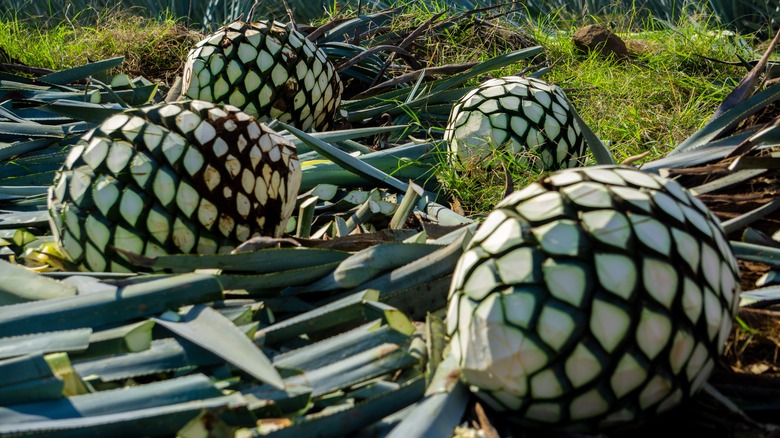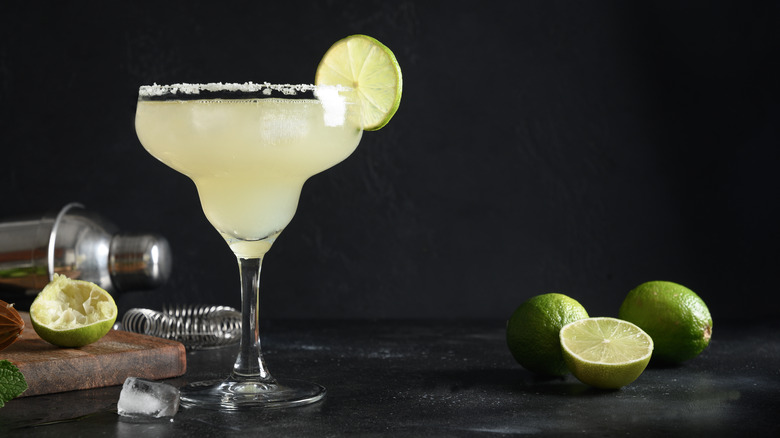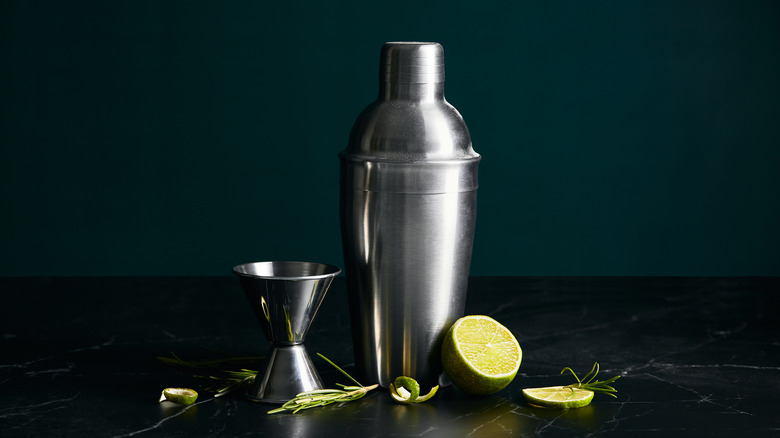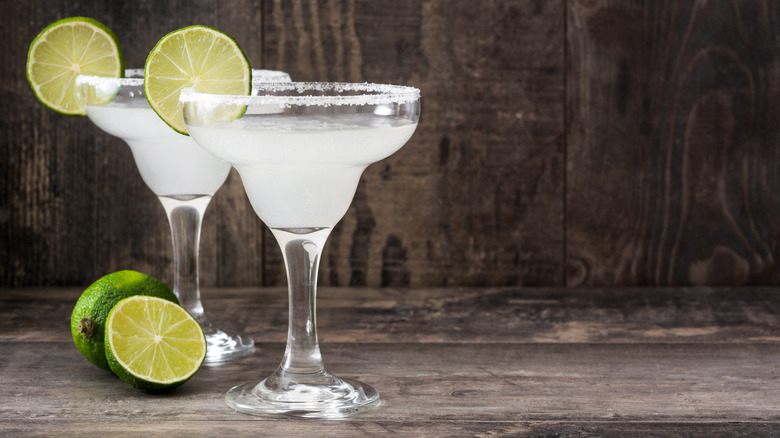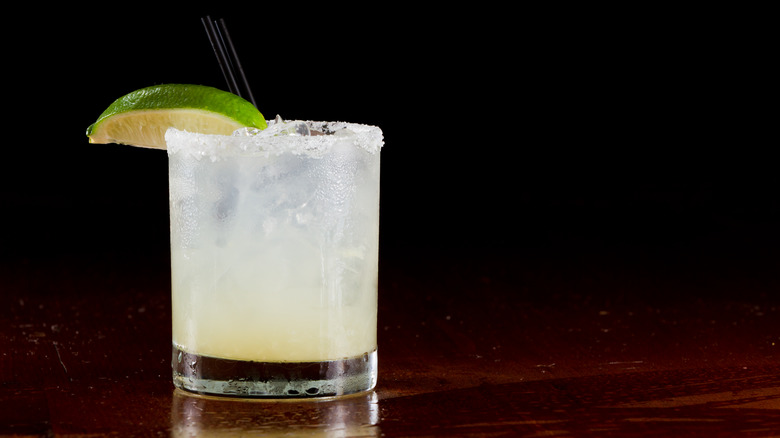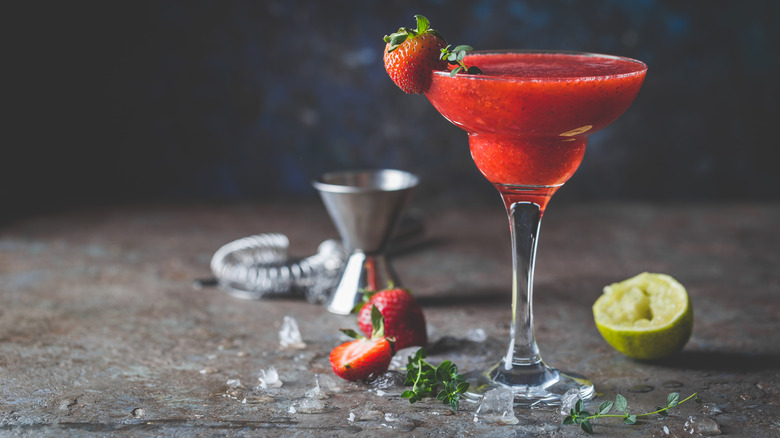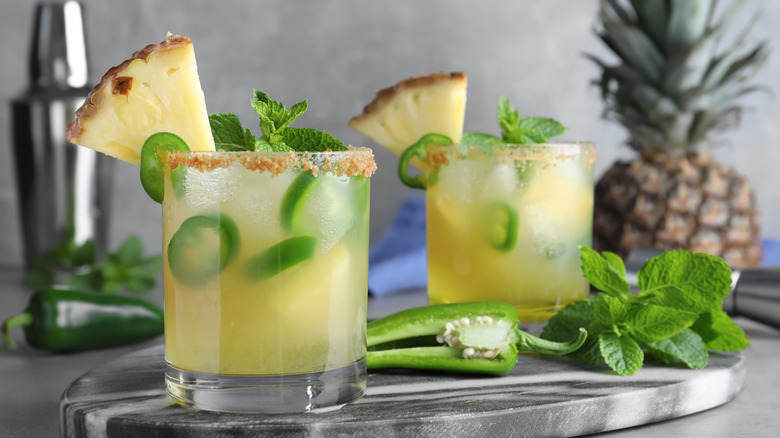12 Essential Tips For Crafting The Perfect Margarita
The iconic combination of tequila, triple sec, and lime juice is a timeless one that brings refreshment, brightness, and a sharp boozy kick with every single sip. While tequila has seen a recent uptick in popularity over the past several years, the margarita has been a classic cocktail for decades.
The earliest known origins of the margarita date back to 1936, when it came about as a member of the daisy family of cocktails, which consist of a spirit, citrus juice, and a sweet liqueur. It had been published as the tequila daisy, the Picador, and the tequila sour before finally being published as the margarita in 1953, the name being the Spanish word for daisy.
Seventy years later, the margarita has sustained as one of the most beloved cocktails around, even earning itself its own national holiday. That's right — this Wednesday, February 22, is National Margarita Day, and there is no better way to celebrate than with an ice-cold margarita.
However, in order to honor the margarita, you will want to make the best one possible. That means fresh ingredients, quality booze, and practicing other important bartending skills. We had the good fortune of consulting Chef Roberto Santibañez of Fonda in New York City. Chef Santibañez is one of the most influential figures in Mexican Cuisine and is a James Beard Award nominee. So, here is everything you need to know to celebrate National Margarita Day with style and refreshment.
Find your favorite tequila
In order to select which tequila is best for your margarita, you must understand the types of tequila that are out there. The most classic and fundamental tequila for a margarita is tequila blanco. These are bottled soon after distillation and are crystal clear, straightforward, and have that iconic agave flavor at the forefront of their profile. Chef Santibañez recommends tequila blanco for a classic margarita because they are the most complimentary to the lime.
There is also reposado, or "rested," tequilas, which are aged oak barrels for a minimum of two months. The tequila accumulates characteristics from the oak, including aromas and flavors of caramel, vanilla, and other barrel notes you would find in bourbon, for example. The agave still takes center stage, but the additional flavor notes simply add more depth and complexity.
No matter what type of tequila you use for your margarita, the most important characteristic is that it is 100% blue agave tequila. Tequilas that are 100% blue agave are the purest form of the spirit, but that does not mean they are expensive. Plenty of 100% blue agave tequilas are available for less than $40 and some even less than $30. Chef Santibañez's ideal choice is Herradura Blanco, priced at an average of just $39. Your margarita is only as good as the tequila you make it with, and finding a well-made bottle is more accessible than you might think.
Know your orange liqueurs
Orange liqueurs are often overlooked as a secondary ingredient, but that does not mean they do not play a vital role. Especially in the margarita, the orange liqueur's bittersweetness helps to form a balance between the vegetal agave flavor of the tequila and the tartness of the lime juice.
There are the classic triple secs from brands, like Giffard and Hiriam-Walker, which are inexpensive and have a very straightforward character that makes them great for margaritas. A more complex orange liqueur that makes a more complex margarita is orange curacao, specifically Pierre-Ferrand. This curacao is made by infusing a grape distillate with orange peels, which makes for a more layered margarita. Gran Marnier is another orange liqueur and is brandy-based. It's its richness will turn the humble cocktail into an upscale one, but it does come with a heftier price tag.
The most iconic and maybe best orange liqueur option for a margarita is undeniably Cointreau. Although this bottle also comes with a larger price than others, Cointreau will always be the reliable go-to for both professional and home bartenders as its character is balanced, bright, and inviting while still coming in at a dry 40% ABV.
If Cointreau's price tag does put you off, Chef Santibañez recommends Combier, which he describes as a predecessor to Cointreau. Combier is available for an average of $31 and gives you everything you love in Cointreau for about $10 less.
Only fresh lime juice
In a cocktail with only three ingredients, each one matters, and the lime juice is no exception. Using freshly pressed citrus juice has been one of the quintessential practices of the modern cocktail renaissance, and for good reason.
First of all, fresh juice simply tastes better. There is no way to tell how long the processed, store-bought lime juice has been sitting on the shelf before you purchase it. Even though the ingredients of some bottles may be within the expiration date, they only last because of added preservatives made from chemicals. Also, as Chef Santibañez points out, fresh lime juice is naturally sweeter and simply tastes better than bottled lime juice, which is sour and bitter.
Using freshly pressed juice had been the standard for mixology in the early days of the cocktail culture in the mid-1800s. Fresh juice was employed and encouraged by mixology legend Jerry Thomas, who approached bartending with the same philosophy chefs do with cooking. Eventually, fresh juice was ditched for the processed stuff, and it was not until the rise of Dale Degroff in the 1980s that fresh juice made a comeback. It has been the standard since.
Buying a bottle of lime juice at the grocery store may be more convenient than buying limes, cutting them in half, and juicing them, but the result of the extra effort is irrefutably far superior.
Avoid margarita mix
Subsequently, you will not be doing yourself any favors with the shortcut which is margarita mix. Again, margaritas are made up of only three ingredients, so combining two of them into one ingredient only diminishes the cocktail.
It turns out, unfortunately, that many Mexican restaurants make margaritas with prepackaged margarita mix instead of freshly pressed juices and quality orange liqueurs. Not only are these margarita mixes inauthentic and lacking in taste, but they are also loaded with added sugars. Having a cocktail or two already comes with concerns about sugar content and dietary setbacks, so having a margarita made fresh with a minimal amount of sugar is certainly more ideal than a combination of sugar and tequila.
The convenience of a margarita mix simply does not translate to a better cocktail, nor does not make that big of a difference in terms of both effort and cost. The price difference between buying a couple of limes and an orange liqueur and a bottle of margarita mix is not substantial, and the orange liqueur is a far more versatile bottle than the sugary, processed margarita mix. Like using store-bought lime juice, the minimal convenience does not actually improve the experience.
Brighten the citrus even more
It is possible that one might prefer margaritas made with margarita mix. However, the chemicals and added sugars in store-bought bottles should be avoided. Luckily, making your own margarita mix is easy and inexpensive.
In addition to pressing fresh citrus juice, you can make a better margarita mix by enhancing the lime even more. This does require some effort ahead of time, but the benefits are well worth it. Before pressing your preferred citrus juices, use a zester to zest the peels of the limes and whatever citrus you are using. Then, after juicing and mixing, add the fresh zest to the juice and let it steep for several hours.
Not only does this make for a naturally enhanced flavor profile, but the zest also does not add any acidity to the mix, so you do not have to worry about compensating for it with the tequila. You can also use whatever citrus you like, such as limes, lemons, oranges, or even grapefruit. If you do prefer the traditional margarita made with just lime juice and orange liqueur, this hack can still be employed by simply adding lime zest to the lime juice ahead of mixing, the result is an even brighter cocktail with a more prolific flavor and aroma.
Punch up the agave
Just as you can enhance the presence of lime in your margarita, you can also enhance the agave notes of the tequila. It has become common practice by bartenders to add a dash of agave nectar to a classic margarita recipe, but the now common addition started as an entirely new take on the classic cocktail.
In the 1980s, Julio Bermejo came up with the Tommy's Margarita for his family's restaurant in San Francisco after discovering 100% blue agave tequila during a trip to Jalisco, Mexico. The riff is a margarita made with tequila, lime juice, and agave nectar — a specialty food item at the time — and no orange liqueur. Tommy's Margarita places all of the emphasis on the agave of the tequila as the nectar brings out even more of the spirit's character.
This modern classic has become more and more popular over the years and has inspired the use of agave nectar in other cocktails, including the traditional margarita. Chef Santibañez is keen on agave too, using it whenever he does not have Cointreau or Combier. Just a bar spoon of the stuff is all that's needed to add another layer of complexity to the cocktail, keeping the harmony of all of the other components intact while also lending more support to the base spirit.
Keep things in balance
The margarita is a wonderfully simple cocktail that, when mixed properly, is one of the most perfectly balanced cocktails there is. However, given that there are only three ingredients, too much or too little of any component will throw this balance off, and your margarita will not turn out the way it should.
There are different ways you can make a margarita, of course, as some people may prefer a margarita with more tartness, more booze, or a more mellow drink altogether. This recipe recommends two ounces of tequila, one ounce of lime juice, half an ounce of triple-sec, and half an ounce of agave nectar. It's a great place to start, and, based on your own personal liking, you can adjust it accordingly.
You should keep in mind that different orange liqueurs have different levels of sweetness. So, if you are using something like Gran Marnier, you should probably pull its measurements back because it is so rich, whereas some like dry curacao can be bumped up to three-quarters of an ounce. This is why Cointreau is such a great choice for margaritas because its dryness, sweetness, and booziness are well-balanced to begin with.
Chef Santibañez points out, however, that too much Cointreau can be overwhelming, and while it is there to keep things in balance, too much of it will throw that balance off completely. Remember that if one measurement changes, you should consider how that change will affect the other ingredients.
Shake hard with good ice
One of the best aspects of what makes the margarita such a great cocktail is that when it is served absolutely ice cold, refreshment reaches its pinnacle. While margaritas are shaken to get their temperature freezing cold, the action accomplishes far more than just chilling and makes for a better cocktail.
For instance, shaking a margarita, or any cocktail for that matter imparts the right amount of dilution very quickly. Dilution is a very important aspect of cocktails, and the small amount of water mixed into the ingredients gives them the right amount of smoothness and texture. Additionally, shaking a margarita aerates the drink. As opposed to stirring cocktail, which achieves a silky smooth texture, margaritas need to be shaken because of the presence of lime citrus juice. Not only is citrus juice easier to mix by shaking, but shaking also makes the cocktail lighter and softer.
The best way to accomplish the right amount of dilution, temperature, and aeration is to shake vigorously with good ice, meaning ice that has been tempered and is, preferably, one large rock. Tempering the ice will allow the dilution to occur at a more controlled rate and using one big cube will help with aeration.
Use the right glassware
In regards to the "perfect margarita," every factor counts. Every alcoholic beverage is best served in the right glass. Certain beers, wines, spirits, and cocktails are meant for specific glassware, ad margaritas are no exception. However, the iconically shaped glasses were never originally meant for margaritas.
As the story goes, a Los Angeles restaurant wrongly received a case of the glasses instead of the champagne flutes they were expecting. The bartender figured they could be used for margaritas, and so they stuck. These margarita coupes are the authentic glassware for the cocktail and are the ones margaritas are actually served in Mexico, Chef Santibañez says.
Of course, the glass you drink your margarita from will not impact its flavor. The cocktail will taste the same whether it is in a margarita glass or a plastic cup. However, the right glassware does contribute to the overall mood of the drink, which does influence the experience of it.
Margarita glasses also have a usual volume of about twice the amount of one margarita. So, if you really want to celebrate, you can do so to the brim, so to speak. Margaritas are also very well-enjoyed in a lowball glass with ice, which will keep the cocktail cold throughout.
Add salt to the rim
Part of the classic image of the margarita is the salted rim. Some people love a salted rim and others do not, so whether you are mixing a margarita for yourself or someone else, here is how you can give the choice with every sip.
According to Chef Santibañez, the best way to add salt to your glass is to slice a lime in half and run the exposed interior along only one side of the glass. Then, either sprinkle the salt directly onto the wetted part of the glass or pour a small amount of salt onto a plate and press the glass into the salt. Then, wait for the lime juice to fully dry before serving. This way, you have the choice of either taking a sip from the section of the glass that has salt on it or not.
Salt is such a great accent to the margarita because it is a natural compliment to the other ingredients. Not only is salt simply a great flavor component on its own, but it enhances the tequila, lime juice, and orange liqueur at the same time. If you really do not like a salted rim but do want to amplify your margarita, adding a tiny pinch of salt to the shaking tin with the other ingredients will accomplish the same dynamic. Also be sure to avoid iodized salt and stick to sea salt, finishing salt, or kosher salt.
Customize it to your liking
There are so many different ways you can make a margarita and so many different ways you can make this cocktail your own. We've already highlighted several, including finding your favorite tequila or orange liqueur, utilizing lime zest and agave, or developing your own preferred recipe.
Another way you can customize your margarita is by flavoring it with various fruits. For example, simply add pineapple juice to the shaker for a pineapple margarita, or muddle some strawberries for a strawberry one. Chef Santibañez's favorite way to customize his margarita is by making spicy margaritas. He makes his by adding different chiles, chipotle peppers, or jalapeños to the mix. If you really like a spicy margarita, you can also rim your glass with spices like cayenne pepper or tajin instead of salt.
There is also the ever-popular and even more refreshing frozen margarita. Adding your margarita ingredients to a blender with ice takes this cocktails refreshment to a whole other level. Margaritas are more than fit for drinking year-round, but the frozen margarita is a must come summertime.
Explore other riffs
The Tommy's Margarita is one of the most famous variations of the cocktail and is a must-try for anyone who likes a margarita, and there are plenty of others worth a try too. For example, the Cadillac Margarita is another well-known riff that is essentially a high-end version of it. These are made using a more upscale bottle of tequila such as a rarer reposado and Grand Marnier rather than regular triple-sec or Cointreau. While the margarita is already an excellent cocktail, the Cadillac Margarita makes it more indulgent and rich.
Another great avenue toward trying different margaritas is by making them with mezcal. Mezcal has grown immensely in popularity over the past decade or so and is being used more and more in bars around the country. It's another agave-based spirit but is made by cooking the agave in an earthen pit and infusing the plant with smoke. This infusion comes out in the flavor profile and is superb in a margarita because of this added layer of character. If you have never had mezcal before, a mezcal margarita is a good introduction to the spirit.
